| کد مقاله | کد نشریه | سال انتشار | مقاله انگلیسی | نسخه تمام متن |
|---|---|---|---|---|
| 2024232 | 1069896 | 2006 | 8 صفحه PDF | دانلود رایگان |

Human NK cell function is regulated by clonally distributed inhibitory receptors termed “Killer cell Immunoglobulin-like Receptors” (KIRs) that recognize epitopes (“KIR ligands”) shared by HLA-C and HLA-B class I allele groups and every functional NK cell in the repertoire expresses at least one receptor for self HLA-class I molecules. Consequently, when NK cells are confronted with allogeneic targets which do not express the inhibiting class I ligand(s) NK cell alloreactions may occur. Donor versus recipient NK alloreactions occur in full HLA haplotype-mismatched (“haploidentical”) hematopoietic transplants that are KIR ligand mismatched in the Graft-versus-Host (GvH) direction. Variable frequencies of functional NK cells in the donor repertoire expressing a KIR for the HLA class I group which is absent in the recipient as their sole inhibitory receptor for self, sense the missing expression of the self class I ligand on allogeneic targets and mediate alloreactions (“missing self” recognition). In clinical trials, donor versus recipient NK alloreactions are highly beneficial as they reduce the risk of leukemia relapse, do not cause GvHD and markedly improve event-free survival.
Journal: Seminars in Cancer Biology - Volume 16, Issue 5, October 2006, Pages 404–411